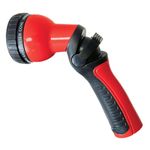
Few plants can put on a spring show as elegant and impressive as wisteria (Wisteria spp. and cvs., Zones 4–9), but like many vines, this plant can be aggressive. Thankfully, wisteria can be tamed by training it into a tree form. This also has a secondary benefit of bringing the fragrant flowers down to eye level.

What types of wisteria are there, and how do they differ?
- There are around 10 species and dozens of varieties of wisteria. The most beloved species are the Asian ones, including Japanese wisteria (Wisteria floribunda, Zones 4–9), Chinese wisteria (Wisteria sinensis, Zones 5–8), and silky wisteria (Wisteria brachybotrys, Zones 5–9).
- The Asian species of wisteria are particularly beautiful, with the longest racemes of flowers. However, they can all be very aggressive, and many are listed on invasive do-not-plant lists. Fortunately, there are native alternatives to these Asian species.
- American wisteria (Wisteria frutescens, Zones 5–9) and Kentucky wisteria (Wisteria frutescens var. macrostachya, Zones 4–9) are easy to find at nurseries. They look different from the Asian species; their flower trusses are not as long, and they bloom after the foliage has started to emerge, while the Asian species bloom before the leaves emerge. However, they otherwise look very similar, and because they are less aggressive, it’s much easier to control and prune them. For the best-performing native cultivars, look for ‘Amethyst Falls’, ‘Blue Moon’, ‘Clara Mack’, and ‘Summer Cascade’.
Tips for growing and training a wisteria vine
Training wisteria isn’t hard at all, but it will require frequent pruning and a firm, permanent stake. Any species can be trained into a vine, but as many gardeners are aware, wisteria can sometimes be fussy about blooming. Flower bud initiation depends on variety and age. Starting off with a grafted vine from a nursery will provide the best results. Avoid seed-raised stock or wild plants.
Basics for successfully training wisteria
If you dream of owning a wisteria trained as a tree, you’ll have the best luck starting off with one that has already been trained to a single stalk. Look for trained and grafted plants online or from a nursery. Mail-order plants will generally be shipped bareroot, but wisteria is forgiving. Soak roots in water overnight, and plant in average garden soil. But expect dormant plants to sulk for a bit, as they can be very late to emerge when first planted, sometimes not sprouting until early summer. Allow plants to settle in for a couple of years before you expect flowers; however, wisteria nativars are more likely to bloom as young plants than other wisterias.

A strong stake is a must
The most important thing to do when adding a trained wisteria tree to your garden is to include a strong stake. It must be permanent and sturdy; a steel pipe is a good option, not wood or bamboo. Remember that wisteria is a vine, not a tree; the main stem will eventually swell over 10 years into a thick, boa constrictor–like trunk; nonetheless, it will remain as flexible as any vine stem. A thick piece of metal will allow the wisteria stem to both wrap and swell around the stake, as well as function as a structure that must ultimately be able to hold the entire weight of the plant above it. Biologically, a vine stem isn’t built to do that by itself.

How to prune wisteria for shape
Wisteria trees should be trained to be no higher than 6 feet tall; most will eventually stoop down a bit as older wood is pruned back and the trunklike stem develops, but this can take years. Hard pruning is essential after bloom, as well as throughout the summer. The goal is to remove any long whips back to the main stem but leave a few inches on each whip with about six or seven leaves, counting back from the old stem. Wisteria generally forms flower buds if given this much space on a limb. Any stem portions remaining may eventually form into branches on the tree form, becoming woodier over the years, so keep the overall shape in mind. Be sure to remove any growth emerging from below the stem graft, the base, or from roots.
In autumn, tidy up vines only by removing seedpods before they mature and cutting any long vinelike whips back for appearances’ sake through the winter. Look for flower buds to emerge in late spring, usually just as the foliage begins to appear.
For more on pruning and training wisteria, read on here. And for more Northeast regional reports, click here.
—Matt Mattus is the author of two books: Mastering the Art of Flower Gardening and Mastering the Art of Vegetable Gardening. He gardens in Worcester, Massachusetts.
Fine Gardening Recommended Products

Dramm Revolution Adjustable 9-Pattern Metal Hose Nozzle
Fine Gardening receives a commission for items purchased through links on this site, including Amazon Associates and other affiliate advertising programs.
- Ergonomic insulated grip
- Maximum pressure of 90 PSI
- Fully adjustable spray pattern
- No trigger lock

Fiskars 7.9-12ft Extendable 2-in-1 Pole Tree Trimmer & Pruner with Rotating Head and Precision-Ground Steel Saw Blade
Fine Gardening receives a commission for items purchased through links on this site, including Amazon Associates and other affiliate advertising programs.

BLACK+DECKER 20V MAX* Cordless Chainsaw, 10-Inch, Tool Only (LCS1020B)
Fine Gardening receives a commission for items purchased through links on this site, including Amazon Associates and other affiliate advertising programs.



















Comments
Log in or create an account to post a comment.
Sign up Log in